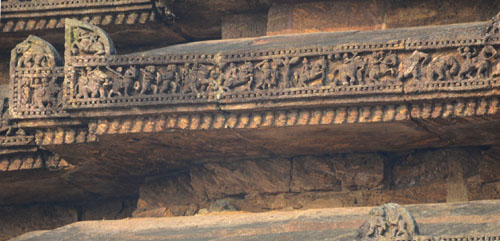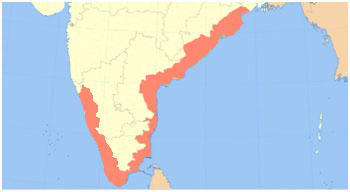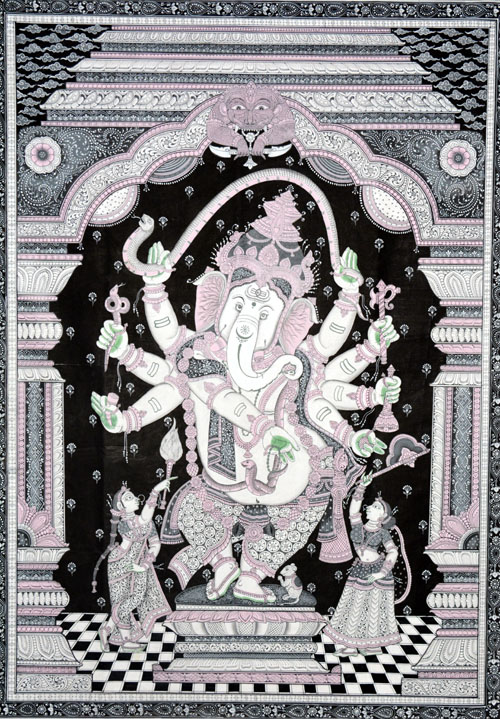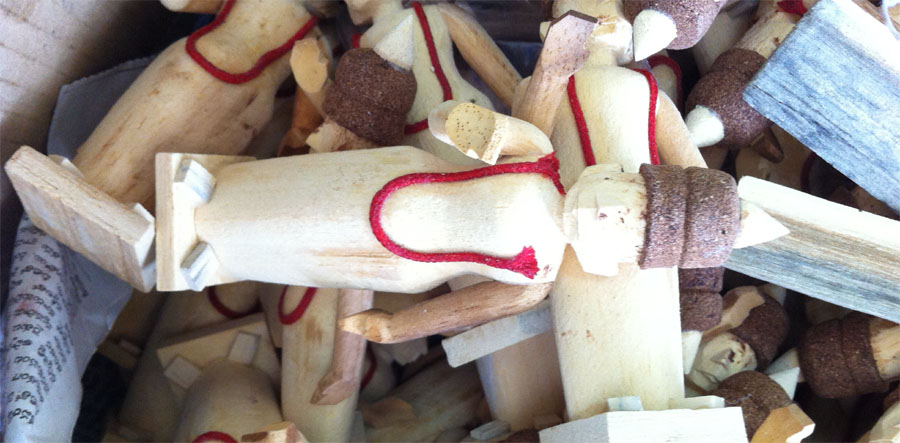This website follows WCAG 2.1 AA guidelines for accessibility. Use Tab to navigate, Enter to activate links, and arrow keys in menus.
Enhancing and Sustaining the Intangible Heritage and Reinventing the Design Paradigm through Encompassing and Expanding Education

India has a vast treasure of artistic expression practised for centuries in different social and cultural contexts, and in various geographical locations across the country. Traditional arts and crafts still continue to define the cultural practices, social processes and economic sustenance of the community, who struggle to uphold their living tradition in the midst of modern transformation.
Despite historical changes, technological advances and globalization, Indian art and craft continue to entice and fascinate people around the world. However, there are many art and crafts forms which have been extinct due to lack of awareness and knowledge transfer.
The Design and Innovation Centre is envisaged to function as a centre of learning and innovation for contributing towards promotion and enrichment of traditional arts and crafts in the South Eastern parts of India.
SPAV is located in the region known for its rich traditional design, such as Kondapalli and Ettikopakka for toys, Pedana and Mangalagri for textiles, Sri Kalahasthi for its wooden carvings and Dharmavaram for its unique leather puppets.
There is another viewpoint that triggered the rationale of establishing a 'Design and Innovation Centre' is the significant transformation in design vocabulary, brought about by accelerating technology and emphasis on interdisciplinary demand of a new age for both learning and practice. Digital experience in designing and human/computer interaction have modified the language and approach to design.
There is a need for education that is grounded in tradition, while directed at the future. The Design and Innovation centre aspires to integrate education, industry and tradition by engaging with artisans, exploring crafts transformation through technological and design intervention and promoting livelihood sustenance through marketing, while preserving the cultural identity.
To explore, enhance and sustain the traditional arts, architecture, crafts and culture of the Southern and Eastern region of India.
To develop design resource unit, that will extend services to industry and use emergent technologies to meet the market demands by providing hands-on experience on innovative methods and use of alternative material and techniques.
To create an incubation cell that would equip artisans, amateur designers, young craftsmen and our students with essential knowledge and skill.
To promote holistic development of the artisan community through knowledge enhancement, exposure, employment generation and creation of avenues to connect and disseminate widely.
To establish state-of-art research facilities, and develop technical expertise and academic diversity for understanding different areas of design and create opportunity for higher education in design at the masters level.
Special targeting will be done for women crafts persons, and underprivileged groups.
Traditional arts and crafts are primarily an occupation, which needs skills, creativity to imagine, visualize and create. The product has two aspects; the material, such as colour and motif, and the symbolic which the product signifies. The first aspect has to do with the technology of the object, and the second is about culture of the people.
Both these aspects are not static, but evolve with time. So, innovations in this field are required to sustain the living heritage through the passage of time, by focusing not just on old technologies and design forms, but on the people of today and the community, who are bearer of the tradition and carrying forward the legacy.

As a national institute, SPAV endeavors to take up the social responsibility, and address the local demands and needs in the field of Design, Planning and Architecture. A Design and Innovation centre is perceived for carrying out research and development on traditional arts and crafts in the Southern and Eastern region of India.
In addition, this centre will serve as a resource and knowledge centre, which will provide incubation and training to artisans, designers and students in the above areas.
SPAV has already interfaced with MSME clusters of Kalamkari association at Pedana and Sri Kalahasti, Kondapalli and Etikoppaka toy makers association and other crafts villages in Durgi, Dharmavaram (Andhra Pradesh), Raghurajpur (Orissa) and other places. Similarly in terms of culture, Krishna District is known for its famous Kathak dance, Gotipua of Raghurajpur, which SPAV intends to integrate with various art forms.
The significance and importance of these crafts and culture need to be seen from the larger perspective. It is noteworthy that the toys, fabrics and other articles made in these regions are eco-friendly, non-toxic and have a lower carbon footprint. Since the current market is looking out for such unique products, this craft when enhanced to meet the international market through technology and market oriented design intervention shall change the livelihood of artisans towards positive direction.
A vehicle for Heritage, Research and Industry
SPAV intends to create a Design cycle conceived as a vehicle to traverse through the heritage spine of traditional art and crafts of Southern and Eastern India with its in-house resource along with the support of other institutions.

A team of Artisans, Students, Faculties and Professionals

India has an enviable inheritance of crafts with over 12 million artisans and more than 500 craft clusters. The skill and ingenuity of India's artisans has found appreciation and patrons around the world. While our craft traditions and techniques date back to centuries, even today master craftsmen and artisans work with passion and commitment carrying forward the legacy of generations, creating handcrafted products that are unique, exceptional and precious.
The vision of SPAV is to drive the School towards sustainable practices and evolve a knowledge base that is progressive and dynamic as well as impart and disseminate strong principles of education and research that is not only state-of-the-art, but also grounded and inclusive of local contexts.
Design as a discipline has the potential in various aspects and has immense contribution for providing balanced and sustainable life. SPAV strives to achieve its vision through its talent resource by collaborating with allied professionals, and most importantly by engaging and connecting with the artisans at the Design and Innovation Centre.
The traditional art and craft forms of Southern and Eastern areas of India

SPAV is located in the mid of the South Eastern coastal belt, which is richly endowed with these intangible heritages. The Centre will focus on revitalization of traditional arts and crafts in the South Eastern coastal region of India, with the scope pertaining to five states namely Andhra Pradesh, Kerala, Karnataka, Odisha and Tamil Nadu.
Among the art and crafts forms such as wooden toys and carvings, Kalamkari art and leather Puppetry, Andhra Pradesh has unique designs of handloom sarees. Many districts of the state have their unique designs including Pochampalli, Mangalgiri, Upada, Venkatgiri, Dharmavaram and Kancheepuram sarees.
The land of temple towns, classical music and dance. Known for stone and bronze carving of Kanchipuram and Mahabalipuram, Thanjavur paintings, wood carving and gold claddings, and palm leaf artefacts of Ramanathapuram and Pullicat.
Known for its unique Odishan style of temple building. The Pattachitra paintings, palm leaf engravings, papier mache work and cow dung toys of Raghurajpur near Puri are traditional art forms practiced by the inhabitants for over centuries.
Kerala is known for its metal, wood and coir crafts along with exquisite designs of lamps. Karnataka features unique paintings and stone and wooden sculptures worth documenting.

In earlier years, designers were trained in form, function, materials, and aesthetics. Today, culture and emotion are central, plus knowledge of societal issues, techniques for finer application and understanding of the intricacies of complex, interdependent systems are important in the context of design education.
There is now a great need to add more emphasis on the findings from the history, social sciences and engineering into the theory and practice of design.
The theoretical foundations of interaction design, user experience, and human-computer interaction provide solid, useful theories and principles, but with little understanding of the aesthetics and traditions that characterize good design. In order to expand, design needs better tools and methods, more theory, more analytical techniques, and more understanding of how art and science, technology and people, theory and practice can mingle effectively and productively is required.


The proposed Design and Innovation Centre is conceived as a research destination and center for advancement of skills with the application of modern scientific and computational teaching methods. The centre is likely to generate huge data related to arts and crafts. To store the data and to develop contemporary applications of the arts, high performance computing systems are required.
The primary aim of this centre is knowledge transfer between students and artisans. Hence, outreach programs play an important role. The centre shall come up with an effective curriculum for offering Masters Degree in Design.
The focus areas of the design and Innovation centre
To exchange the knowledge base between traditional artisans and students
To extend these traditional art to other applications
To upgrade the working conditions and maximizing the profit for the artisans
To innovate semi-mechanized tools to enhance the production process
To sustain the production process for the continuous livelihood of the artisans
To train our students at Master's Level in Design (Product and Industrial Design)
It is proposed to take up the Design and Innovation Centre in three phases for the duration of two years and each phase is divided into the duration of 8 months. Phase I involves the base work such as collection of raw data, setting up of permanent laboratory, organizing workshops & national level design competitions, capacity building programs etc. Phase II focus mainly on measures to increase the production through innovation of semi mechanized tools. The last phase focus on application of these traditional arts and crafts to suit the contemporary needs.
For the Design and Innovation Centre to succeed, grow, achieve its potential, and train future designers, a centre is envisioned that is strongly rooted to tradition and yet is a dynamic cycle of heritage, research and industry, which will be acquiring scientific knowledge, understanding of experimental methods and rigorous reasoning, and continue the process of innovation to carry forward the vision of SPAV.
Published 2015
By School of Planning and Architecture, Vijayawada
Sy. No: 71/1, NH 5, Nidamanuru
Vijayawada - 521104
Krishna District, Andhra Pradesh, India
© 2015 School of Planning and Architecture, Vijayawada. All rights reserved.
Photos: © SPA Vijayawada collective